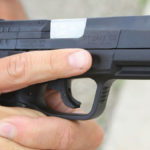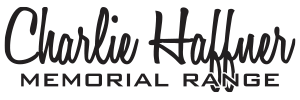At the Range…
Gun barrels pointed down range at all times!
If you set a firearm down on the bench it must always be cleared and the muzzle must pointed down range!
If your firearm is cased, set the case down so that the muzzle of the weapon is pointed down range when you uncase it!
Loaded firearms are not allowed on the rear benches. All weapons on the rear benches must be unloaded and shown clear, magazines out, slides locked back, bolts open.
We call the range clear every 30min. On the hr and half hr. This is the time you can proceed down range to pull or post targets. There is no of handling of firearms during a clear. When all targets have been posted and everyone is back we call the line HOT. Once the line has been called hot you may then go back to handling weapons and shooting.
Do not touch guns during a Clear! Every 30min you will hear these commands! Listen and follow them! CLEAR! MAKE THE LINE SAFE! BENCH ALL FIREARMS, MAGAZINES OUT, SLIDES LOCKED BACK, BOLTS OPEN, NO HANDLING FIREARMS WHILE PEOPLE ARE DOWN RANGE, ARE WE CLEAR IN THE PIT? (IF YOU ARE IN THE PISTOL PIT, YOU RESPOND BY YELLING BACK “CLEAR!” ONCE WE GET A RESPONSE FROM THE PISTOL PIT WE GIVE THE COMMAND “YOU CAN NOW PROCEED DOWN RANGE TO PULL OR POST TARGETS, DO NOT TOUCH YOUR GUNS DURING A CLEAR!
The 4 rules of gun safety
The 4 rules were created to ensure that no accidents happen. If these rules are followed 100% of the time, you can rest assured that you will never have an accident with your firearms. We recommend taking some gun safety classes to have a better understanding of how a firearm works and how to keep yourself and everyone around you safe when using guns. Reading the reviews of different guns and hunting rifles would also help. We are not sure who created these rules and they vary depending on the source. The below list of these 4 rules is how we like to describe them.
The 1st Rule: Treat a Gun as if it is always loaded
Imagine you’re at the range and a buddy of yours has a new gun that he just picked up. He asks if you want to shoot it and you say “Heck Yeah!”. Even if he shows you that the gun is clear and sets it down, the first thing you should always do when you pick it up is to safety-check it and make sure it is not loaded. This also applies to setting it down again. Whenever the gun is out of your control, even if you set it on a table for 30 seconds, ALWAYS safety-check it to make sure it is not loaded when you pick it back up. Additionally, even after checking the guns, always treat them as if they were loaded and ready to fire. There is no exception to this rule.
The 2nd Rule: Never point a Gun, loaded or not, at something you are not prepared to destroy
If you’ve done your safety-check and are absolutely sure that your gun is unloaded, that does not give you the go-ahead to be careless with it. Remembering the first rule, The Gun Is ALWAYS Loaded, you should never point it toward anything that you are not prepared to destroy.
The 3rd Rule: Always be sure of your target and what is behind it
Bullets can go through, and beyond, your intended target. Knowing what’s behind your target is essential as you are responsible and liable for anything you bullet hits.
The 4th Rule: Keep your finger off the trigger until your sights are on your intended target
This 4th rule, and arguably the most important, should be practiced 100% of the time (as with all of these rules). With any modern firearm, as long as your finger is away from the trigger and the trigger guard, your firearm will not fire. Knowing and following this rule, there should be 0% chance of a negligent discharge. Notice we didn’t say ‘accidental discharge’, because there is no such thing. It’s negligent, period.
 Every single time that you pick up a firearm, you should be doing it as shown in the image to the left. With this mindset each and every time, it will become second nature. Should you have to draw your firearm one day, you will instinctively place your trigger finger along the frame and slide instead of directly on the trigger or inside the trigger guard.
Every single time that you pick up a firearm, you should be doing it as shown in the image to the left. With this mindset each and every time, it will become second nature. Should you have to draw your firearm one day, you will instinctively place your trigger finger along the frame and slide instead of directly on the trigger or inside the trigger guard.
A few More…
Always Wear Eye And Ear Protection When Shooting
Always wear protective shooting glasses and some form of hearing protectors while shooting. Exposure to shooting noise can damage hearing, and adequate vision protection is essential. Shooting glasses guard against twigs, falling shot, clay target chips and the rare ruptured case or firearm malfunction. There are a wide variety of eye and ear protectors available.
If Your Gun Fails To Fire When The Trigger Is Pulled, Handle With Care!
Occasionally, a cartridge may not detonate when the trigger is pulled. If this occurs, keep the muzzle pointed in a safe direction and wait 30 seconds. Keep your face away from the breech. Then, carefully open the action, unload the firearm and dispose of the cartridge in a safe way. Any time there is a cartridge in the chamber, your gun is loaded and ready to fire even if you’ve tried to shoot and it did not go off. It could go off at any time, so you must always remember Rule #1 and watch the muzzle!
Be Sure The Barrel Is Clear Of Obstructions Before Shooting
Before you load your firearm, open the action and be certain that no gun ammunition is in the chamber or magazine. Be sure the barrel is clear of any obstruction. Even a small bit of mud, snow, excess lubricating oil or grease in the bore can cause dangerously increased pressures, causing the barrel to bulge or even burst on firing, which can cause injury to the shooter and bystanders. Make it a habit to clean the bore and check for obstructions with a cleaning rod immediately before you shoot it. If the noise or recoil on firing seems weak or doesn’t seem quite “right,” cease firing immediately and be sure to check that no obstruction or projectile has become lodged in the barrel.
6 RULES TO REMEMBER
1. CHECK IN AT THE RANGE OFFICE UPON ARRIVAL.
2. GUN BARRELS POINTED DOWN RANGE AT ALL TIMES.
3. NO HANDLING FIREARMS DURING A CLEAR.
4. POST YOUR TARGETS ON THE CARDBOARD, DO NOT COVER ANY OF THE ORANGE WOODEN TARGET FRAME.
5. NO MAG DUMPS, DOUBLE TAPS OR RAPID FIRE ON THE MAIN FIRING LINE.
6. CLEAN UP YOUR SHOOTING AREA BEFORE YOU LEAVE. PULL YOUR POSTED TARGETS, THROW YOUR TRASH AWAY, CHAIRS BACK ON THE REAR BENCH, RETURN SHOOTING BLOCKS AND SPOTTING SCOPES, CLEAN UP YOUR EMPTY SHELL CASINGS. LEAVE YOUR SHOOTING AREA CLEANER THAN YOU FOUND IT.
